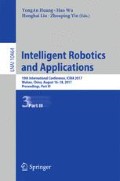Abstract
In this paper, we proposed a method for plant classification, which aims to recognize the type of leaves from a set of image instances captured from same viewpoints. Firstly, for feature extraction, this paper adopted the 2-level wavelet transform and obtained in total 7 features. Secondly, the leaves were automatically recognized and classified by Back-Propagation neural network (BPNN). Meanwhile, we employed K-fold cross-validation to test the correctness of the algorithm. The accuracy of our method achieves 90.0%. Further, by comparing with other methods, our method arrives at the highest accuracy.
Access this chapter
Tax calculation will be finalised at checkout
Purchases are for personal use only
References
Carro, F., Soriguer, R.C.: Long-term patterns in Iberian hare population dynamics in a protected area (Donana National Park) in the southwestern Iberian Peninsula: effects of weather conditions and plant cover. Integr. Zool. 12, 49–60 (2017)
Lim, S.H., et al.: Plant-based foods containing cell wall polysaccharides rich in specific active monosaccharides protect against myocardial injury in rat myocardial infarction models. Sci. Rep. 6, 15 (2016). Article ID: 38728
Du, J.X., et al.: Computer-aided plant species identification (CAPSI) based on leaf shape matching technique. Trans. Inst. Meas. Control 28, 275–284 (2006)
Heymans, B.C., et al.: A neural network for Opuntia leaf-form recognition. In: IEEE International Joint Conference on Neural Networks, pp. 2116–2121. IEEE (1991)
Wu, S.G., et al.: A leaf recognition algorithm for plant classification using Probabilistic Neural Network. In: International Symposium on Signal Processing and Information Technology, p. 120. IEEE (2007)
Wang, X.F., et al.: Classification of plant leaf images with complicated background. Appl. Math. Comput. 205, 916–926 (2008)
Jeatrakul, P., Wong, K.W.: Comparing the performance of different neural networks for binary classification problems. In: Eighth International Symposium on Natural Language Processing, Proceedings, pp. 111–115. IEEE (2009)
Dyrmann, M., et al.: Plant species classification using deep convolutional neural network. Biosyst. Eng. 151, 72–80 (2016)
Zhang, S.W., et al.: Semi-supervised orthogonal discriminant projection for plant leaf classification. Pattern Anal. Appl. 19, 953–961 (2016)
Meier, D.C., et al.: Fourier transform infrared absorption spectroscopy for quantitative analysis of gas mixtures at low temperatures for homeland security applications. J. Testing Eval. 45, 922–932 (2017)
Tiwari, S., et al.: Cloud point extraction and diffuse reflectance-Fourier transform infrared spectroscopic determination of chromium(VI): A probe to adulteration in food stuffs. Food Chem. 221, 47–53 (2017)
Garrido, M.: The feedforward short-time fourier transform. IEEE Trans. Circ. Syst. II-Express Briefs 63, 868–872 (2016)
Saneva, K.H.V., Atanasova, S.: Directional short-time Fourier transform of distributions. J. Inequal. Appl. 10, Article ID: 124 (2016)
Huo, Y., Wu, L.: Feature extraction of brain MRI by stationary wavelet transform and its applications. J. Biol. Syst. 18, 115–132 (2010)
Ji, G.L., Wang, S.H.: An improved reconstruction method for CS-MRI based on exponential wavelet transform and iterative shrinkage/thresholding algorithm. J. Electromag. Waves Appl. 28, 2327–2338 (2014)
Yang, M.: Dual-tree complex wavelet transform and twin support vector machine for pathological brain detection. Appl. Sci. 6, Article ID: 169 (2016)
Liu, A.: Magnetic resonance brain image classification via stationary wavelet transform and generalized eigenvalue proximal support vector machine. J. Med. Imaging Health Inform. 5, 1395–1403 (2015)
Bezawada, S., et al.: Automatic facial feature extraction for predicting designers’ comfort with engineering equipment during prototype creation. J. Mech. Des. 139, 10 (2017). Article ID: 021102
Gerdes, M., et al.: Decision trees and the effects of feature extraction parameters for robust sensor network design. Eksploat. Niezawodn. 19, 31–42 (2017)
Zhang, Y.: Binary PSO with mutation operator for feature selection using decision tree applied to spam detection. Knowl. Based Syst. 64, 22–31 (2014)
Yang, J.: Preclinical diagnosis of magnetic resonance (MR) brain images via discrete wavelet packet transform with Tsallis entropy and generalized eigenvalue proximal support vector machine (GEPSVM). Entropy 17, 1795–1813 (2015)
Phillips, P., et al.: Pathological brain detection in magnetic resonance imaging scanning by wavelet entropy and hybridization of biogeography-based optimization and particle swarm optimization. Prog. Electromag. Res. 152, 41–58 (2015)
Sun, P.: Pathological brain detection based on wavelet entropy and Hu moment invariants. Bio-Med. Mater. Eng. 26, 1283–1290 (2015)
Wei, L.: Fruit classification by wavelet-entropy and feedforward neural network trained by fitness-scaled chaotic ABC and biogeography-based optimization. Entropy 17, 5711–5728 (2015)
Yang, J.: Identification of green, Oolong and black teas in China via wavelet packet entropy and fuzzy support vector machine. Entropy 17, 6663–6682 (2015)
Zhou, X.-X.: Comparison of machine learning methods for stationary wavelet entropy-based multiple sclerosis detection: decision tree, k-nearest neighbors, and support vector machine. Simulation 92, 861–871 (2016)
Sharma, B., et al.: Traffic accident prediction model using support vector machines with Gaussian kernel. In: Fifth International Conference on Soft Computing for Problem Solving, pp. 1–10. Springer, Berlin (2016)
Maleszka, M., Nguyen, N.T.: Using subtree agreement for complex tree integration tasks. In: Selamat, A., Nguyen, N.T., Haron, H. (eds.) ACIIDS 2013. LNCS, vol. 7803, pp. 148–157. Springer, Heidelberg (2013). doi:10.1007/978-3-642-36543-0_16
Anastasiu, D.C., Karypis, G.: Fast parallel cosine k-nearest neighbor graph construction. In: 6th Workshop on Irregular Applications: Architecture and Algorithms (IA3), pp. 50–53. IEEE (2016)
Nguyen, H.D., et al.: A universal approximation theorem for mixture-of-experts models. Neural Comput. 28, 2585–2593 (2016)
Acknowledgment
This paper is financially supported by Natural Science Foundation of China (61602250), Natural Science Foundation of Jiangsu Province (BK20150983).
Author information
Authors and Affiliations
Corresponding author
Editor information
Editors and Affiliations
Rights and permissions
Copyright information
© 2017 Springer International Publishing AG
About this paper
Cite this paper
Yang, MM., Phillips, P., Wang, S., Zhang, Y. (2017). Leaf Recognition for Plant Classification Based on Wavelet Entropy and Back Propagation Neural Network. In: Huang, Y., Wu, H., Liu, H., Yin, Z. (eds) Intelligent Robotics and Applications. ICIRA 2017. Lecture Notes in Computer Science(), vol 10464. Springer, Cham. https://doi.org/10.1007/978-3-319-65298-6_34
Download citation
DOI: https://doi.org/10.1007/978-3-319-65298-6_34
Published:
Publisher Name: Springer, Cham
Print ISBN: 978-3-319-65297-9
Online ISBN: 978-3-319-65298-6
eBook Packages: Computer ScienceComputer Science (R0)

